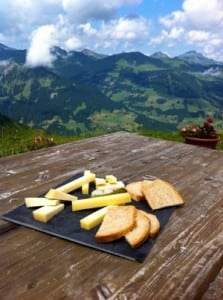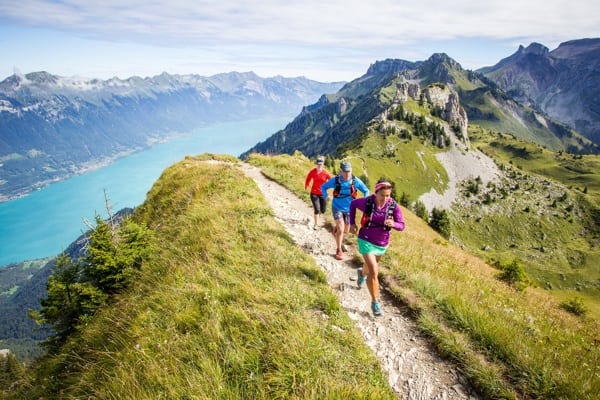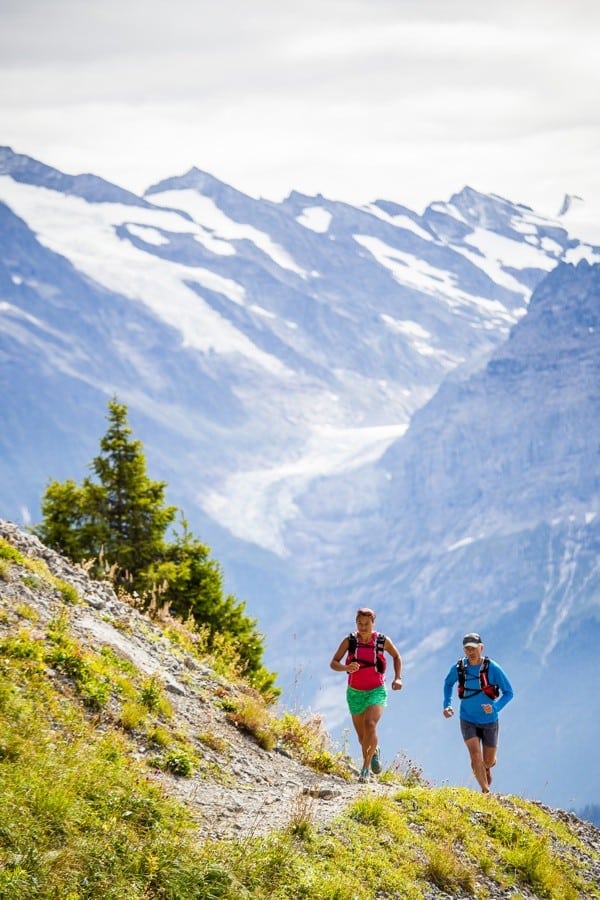[Editor’s Note: The below article is part of a series that profiles trail running in various countries around the world. We’ve recruited local experts for each of the posts. Please get in touch if you are interested in having your country profiled.]
Trail Running in Switzerland
By Doug Mayer, owner of Run the Alps with assistance from Troy Haines, owner of Alpinehikers.
Weaving through a herd of cows in a high mountain pasture. Running across an ancient glacier. Enjoying slabs of fresh bread and cheese, before hopping on the next téléphérique to the valley. Locals cheering you on with cries of “Allez-Allez!” and “and Hopp, Hopp!”
Trail running in Switzerland is filled with these little moments, which, when they blend together, create some of the great spirit of running through the Swiss Alps. Switzerland is a country that might well have been created by trail runners—trail runners who love great food, convenient pit stops, and creative mountain transportation when it’s time to call it a day.

Running in the Berner Oberland. Photo: Patitucci Photo
Perhaps no country has been more stereotyped that Switzerland, which often gets reduced down to cheese, chocolate, lush pastures, and high peaks. The thing is… it’s all pretty much true. And the Swiss, stereotyped as a highly efficient people who value tidiness, order, and an on-time train schedule? Yep. Pretty much.
But, get closer, and beautiful, more nuanced qualities reveal themselves. An understated friendliness. Heartfelt pride in all things Swiss, from the cuisine, to the head-scratching ‘How’d they do that?’ mountain transportation. A deep desire to make sure that guests are having a great experience. And an abiding love of their vertiginous landscape.
All of these facets mix together to create a trail running scene not to be missed. Just be sure to bring a camera and the biggest memory card you can score. At least a few of those photos are going to end up on a wall at home. We guarantee it.
The Trail Running Upsides…
How best to describe trail running in Switzerland? Here’s our list.

Lunch at Cabane Antheme.
Photo: Doug Mayer
- Mountain infrastructure that facilitates trail running. Want to run from one village, over a few passes, and be back in time for dinner? In Switzerland, you can do it, and often very easily. Between the federal SBB rail system, local trains, Post busses, and even boats, getting around is simple. Up high, gondolas, trams, funiculars, and odd hybrids that look like they were designed by Rube Goldberg’s Swiss cousin, all serve to move mountain travelers without a hitch.
- Over 300 huts. The legendary Swiss Alpine Club oversees more than 150 huts, from local cabins managed by a single guardian, to world-renowned installations like the new Monte Rosa hutte. An equal number of privately managed huts compliment the Swiss Alpine Club’s offerings, and run the gamut from unique, 19th century places like the Hotel Weisshorn to small family businesses. At the highest alpine elevations, food and drink are delivered by helicopter and can often be simple and on the costly side, but most other huts feature a variety of offerings that, well, can cause drool-inducing double takes. Café au lait and freshly baked blueberry tart? No problem. Cheese plate, fresh bread, and wine? De rien! The most frequently overheard comment from a first-time Switzerland trail runner? “Ya know… I could get used to this.”
- A trail system that is arguably the most impressive in the world, with over 50,000k (30,000 miles) of maintained paths, seven national trails, and a spider web of options in each major valley. Go to the center of any Swiss alp village, and you’ll find a signpost with trails leading in every direction. It’s there in each town, and shows perfectly the important role that Switzerland’s trails play in the life of the country. This densely interlaced network of trails also means you don’t need to decide how far you’re running when you start your run. Want to head back to town early? There’s a trail for that. Feeling good and want to keep going? There’s one around the corner. Or five.
- A ‘sportif’ culture that celebrates trail runners. Brace yourself: if you run in Switzerland, you’ll be applauded by locals. Be ready for the moment, and toss them a casual, “Guten morgen” in the Bernese Oberland or “Bon matin” in the Valais Alps. Even if you don’t get it quite right, you’re likely to get a big smile back.
- A variety of welcoming cafes, inns, and farm stops along every route. Some of the stops are so informal as to be unstaffed, with a fridge, a note, and a jar for your Swiss francs. Others, in the most improbable of locations, will leave you scratching your head with their range of wines and fresh-baked tarts.
… And the Downsides
No honest appraisal of a destination is complete without mentioning a few of the downsides. Here’s what might catch you off guard when running in Switzerland:
- Be careful with your shopping. Not everything is pricey, but from time to time, you will find yourself saying, “Really?!” Here are our tips for avoiding sticker shock: Don’t get a haircut, skip the fancy watch, and don’t buy your Salomon compression shorts in Switzerland. Switzerland’s well-managed economy often results in higher prices, and a lot of goods are 10% to 20% more expensive than in the United States. The good news? Really good cheese is cheap and, if you’re like some of us, you’ll make up for it right there!
- Mountain weather. The Alps are one of the world’s big ranges. They are their own weather makers, and not all of it is good. Clouds can settle in for days at a time, and it’s not unheard of to be hit with a first significant snow late in August, especially over 2,000 meters (6,500 feet) in elevation. Be ready to run in chilly conditions with wind, rain, and maybe some snow, too.
- It’s vertical. Expect to spend at least an hour every day digging down deep for a solid uphill push. The Alps are steep. On the upside, the trail makers often had flocks of sheep or herds of cows in mind, so switchbacks abound. At some point during your run, be ready to put your head down for an hour, and burn some calories. It’ll be worth it. Besides, as you run, the odds are a hut caretaker is baking something seriously tasty at the next hut!

Another downside: Swiss traffic jams. Photo: Doug Mayer
Where to Go
Even though Switzerland is less than half the size of the state of Maine, the range and diversity of trail running makes it challenging to summarize. However, the most popular mountain running takes place in two well-known alp regions, the Valais and the Bernese Oberland.
The Valais. This canton, one of 26 in Switzerland, is noted for its wine, its sporting culture and, of course, its beautiful Alps. Situated along the border with France and Italy, the Valais is home to fifty peaks over 4,000 meters (13,000 feet), among them a number of peaks in the Mont Blanc massif, and arguably the most famous peak in the world, the Matterhorn. The Rhône valley bisects the canton, and is home to the cities of Martigny, Sion, Sierre, Brig, and Visp. With many of Switzerland’s best-known trail races, the Valais is often considered the epicenter for trail running in the country. Valais residents speak French and German. The major mountain destinations include Zermatt, Saas Fee, and Leukerbad, while quieter areas excellent for trail running include Bettmeralp, the Lötschental valley, Champery, Champex, and Trient, among many others.
Bernese Oberland. Part of the German-speaking canton of Bern, the Oberland, or highland, encompasses some of Switzerland’s most renowned scenery and peaks including the Eiger, Monch, and Jungfrau, the Lauterbrunnen valley, and the well-known towns of Interlaken, Grindelwald, and Meiringen. Much of the area is part of the UNESCO Jungfrau-Aletsch-Bietschhorn World Heritage Area. Trail running through the Bernese Oberland, it’s hard not to find yourself thinking that the Swiss Tourism Bureau is somehow watching you, assuring a classic Swiss moment around every turn. When you don’t see a local resident with an alphorn, or a herd of cows in the next pasture, you’ll worry that something went awry. Smaller villages well-suited for trail running include Kanderstag, Lenk, Adelboden, Murren, and Engelberg, among literally dozens of others.

Running through the Berner Oberland. Photo: Patitucci Photo
Together, the Bernese Oberland and the Valais are home to many of the better-known mountains of Switzerland. A trail runner looking to explore a bit, however, will be rewarded with a cornucopia of lesser-traveled trails through stunning terrain. Entire regions can be explored for weeks at a time. The most notable areas include the Jura range on the border with France, the quiet valleys of the Engadine, the Italian-speaking Ticino region, and the culturally rich Appenzell to the north. The ‘prealp’ canton of Vaud offers gentler, more bucolic terrain, and includes some of the most notable villages of Switzerland, including Gstaad, Gruyeres, and Leysin.
The Racing Scene
It’s barely an overstatement to say that just about every village in the Swiss Alps has its own race. There are over 70 trail races each year, from April through to early November. Events range from some of the best-known mountain runs in the world such as International Skyracing Federation races Sierre-Zinal and Matterhorn Ultraks, to welcoming, village affairs like Fully-Sorniot, Trail Dents du Midi, and Chandolin’s double, vertical kilometer. Switzerland features a number of quirky races, too, including the DIY race up to the top of Gemmipass at Leukerbad, a run that finishes across a glacier, and a biannual cross-border run from Italy to Switzerland.

Kilian Jornet running Sierre-Zinal. Photo: Doug Mayer
The Valais region, in particular, has become home to a number of mountain runners from around the world. The country doesn’t lack for local talent, either. At last year’s Sierre-Zinal, Neuchâtel resident Marc Launenstein beat out some of the biggest names in the sport for the win. Emmanuel Vaudan, a noted Valais local, has held the world record for the fastest vertical kilometer.
Most trail race registration is handled online through the company Datasport. Many races include a faster ‘elite’ division and a more casual ‘tourist’ division for recreational runners and, often, Nordic walkers. Running poles can be helpful on steeper courses, but they’re not allowed in all races.
Getting Around
To make getting around Switzerland any easier, the tourism bureau would have to to start providing personal chauffeurs. The federal rail system, SBB CFF FFS, is accessible at both Geneva and Zurich airports. SBB meshes with regional and local trains, Post busses, trams, and funiculars about as seamlessly as one could imagine.
A variety of SBB travel passes are available. Most tourists opt for a flexi-pass of some kind, which offers discounts on almost any form of transportation, from intercity trains to local chairlifts. If you’re staying for more than a few days, consider purchasing a Rega air ambulance card. Your annual dues will cover air evacuation, which is the preferred transport means for anyone seriously hurt or injured in the mountains. Free wifi is widely available at cafes, restaurants, and hotels, so most travelers opt for bringing their own phones and using Skype’s phone app for nearly-free calling. If staying in touch is important for you, add an international plan to your phone. Be sure to turn data roaming off on smartphones, or you might incur some bank-account-crushing charges.
Switzerland really is a mountain runner’s paradise. With a little planning, it’s not hard to design a day that features rolling mountain pastures, dramatic peaks, fresh local food, and a variety of huts en route. And when you’re tired? There’s a tram to take you back to the village, a glass of wine, and a view of the day’s route. Innkeepers will cheer your accomplishments, and, sooner or later, you’ll catch yourself saying, “I could get used to this.”

Trail running in Berner Oberland. Photo: Patitucci Photo
Resources
- Swiss Trail Races
- Datasport (race registation)
- Meteo Schweiz (Swiss weather)
- SBB (train system)
- Swiss Alpine Club (hut system)
- Rega (air evacuation)
Related Stories

Running in the Berner Oberland. Photo: Patitucci Photo
